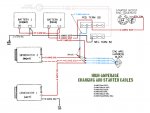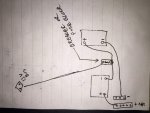The fusible links in the diagram you published in the first post are meant only to protect the wiring of the alternator power lines - that's simple, no calculation required, pick a fuse at the output rating of the alternator. In the diagram, I don't like that the starter line goes through a power block, that's two more connectors (from the battery, to the starter) and a power block that can all add corrosion failure points. The starter circuit, and the NATO jump port, are
very high current circuits. Yes after the starting/charging circuits, the glow plugs are probably your next highest load, then your headlights, your wiper motor, your brake lights and turn signals, and finally your parking lights. The blackout lights are LED on the CUCV (except for the blackout driving light, which draws about as much as one parking bulb).
I used to do car stereos in the mid 90's, I'd recommend a secondary fuse block rather than messing with your original wiring at all. You can convert the radio power port behind the passenger seat to a 12-volt only to run loads off of, or even better leave it 24Volts and run a 60Amp Vanner off of it to charge an auxiliary battery just for your new accessories. This prevents your new loads from sucking your starting batteries dry, and spreads the charging load over both alternators.

So you'd keep the entire 12v system and both alts on 8 AWG?
Good clean 8Gauge copper wire has a resistance of about 0.0062996Ohms per foot (this is "wire loss"). Assuming a 20 foot run (10-feet there, 10-feet back), this is a total resistance of about 0.0126Ohms, which in a 28.8Volt electrical system with 100Amps current (CUCV alternator rating) works out to about 4.5% loss end-to-end. It's under 5%, so yes I would consider it acceptable, 6Ga would be better yes, but that would be your decision

opcorn:.
Again the starting circuit is the highest pulse load, the NATO port is intended to be part of a starting circuit.





